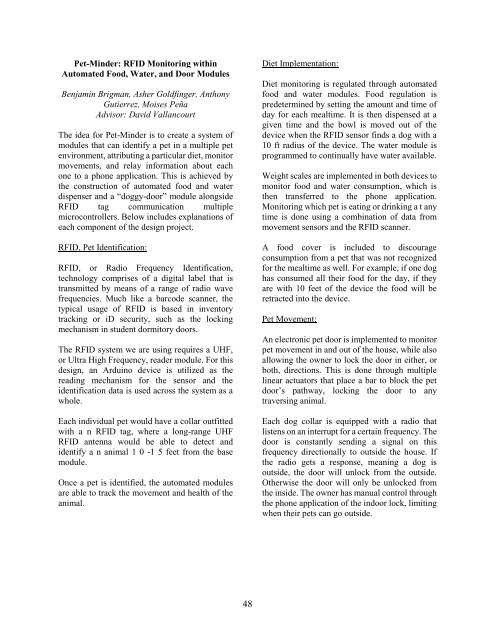Senior Design Expo 2019
The Senior Design Expo, held annually in May at Columbia University, is an opportunity for Columbia Engineering students to showcase what they have learned in their foundational math and science courses together with their engineering courses in innovative, creative, and purposeful designs and prototypes. Each year the Expo showcases more than 60 projects across all nine departments. Projects have included cutting-edge robotics, the New York City subway system, language technology, proposals for bridges to span the Hudson river, and much more.
The Senior Design Expo, held annually in May at Columbia University, is an opportunity for Columbia Engineering students to showcase what they have learned in their foundational math and science courses together with their engineering courses in innovative, creative, and purposeful designs and prototypes. Each year the Expo showcases more than 60 projects across all nine departments. Projects have included cutting-edge robotics, the New York City subway system, language technology, proposals for bridges to span the Hudson river, and much more.
You also want an ePaper? Increase the reach of your titles
YUMPU automatically turns print PDFs into web optimized ePapers that Google loves.
Pet-Minder: RFID Monitoring within<br />
Automated Food, Water, and Door Modules<br />
Benjamin Brigman, Asher Goldfinger, Anthony<br />
Gutierrez, Moises Peña<br />
Advisor: David Vallancourt<br />
The idea for Pet-Minder is to create a system of<br />
modules that can identify a pet in a multiple pet<br />
environment, attributing a particular diet, monitor<br />
movements, and relay information about each<br />
one to a phone application. This is achieved by<br />
the construction of automated food and water<br />
dispenser and a “doggy-door” module alongside<br />
RFID tag communication multiple<br />
microcontrollers. Below includes explanations of<br />
each component of the design project.<br />
RFID, Pet Identification:<br />
RFID, or Radio Frequency Identification,<br />
technology comprises of a digital label that is<br />
transmitted by means of a range of radio wave<br />
frequencies. Much like a barcode scanner, the<br />
typical usage of RFID is based in inventory<br />
tracking or iD security, such as the locking<br />
mechanism in student dormitory doors.<br />
The RFID system we are using requires a UHF,<br />
or Ultra High Frequency, reader module. For this<br />
design, an Arduino device is utilized as the<br />
reading mechanism for the sensor and the<br />
identification data is used across the system as a<br />
whole.<br />
Each individual pet would have a collar outfitted<br />
with a n RFID tag, where a long-range UHF<br />
RFID antenna would be able to detect and<br />
identify a n animal 1 0 -1 5 feet from the base<br />
module.<br />
Once a pet is identified, the automated modules<br />
are able to track the movement and health of the<br />
animal.<br />
Diet Implementation:<br />
Diet monitoring is regulated through automated<br />
food and water modules. Food regulation is<br />
predetermined by setting the amount and time of<br />
day for each mealtime. It is then dispensed at a<br />
given time and the bowl is moved out of the<br />
device when the RFID sensor finds a dog with a<br />
10 ft radius of the device. The water module is<br />
programmed to continually have water available.<br />
Weight scales are implemented in both devices to<br />
monitor food and water consumption, which is<br />
then transferred to the phone application.<br />
Monitoring which pet is eating or drinking a t any<br />
time is done using a combination of data from<br />
movement sensors and the RFID scanner.<br />
A food cover is included to discourage<br />
consumption from a pet that was not recognized<br />
for the mealtime as well. For example, if one dog<br />
has consumed all their food for the day, if they<br />
are with 10 feet of the device the food will be<br />
retracted into the device.<br />
Pet Movement:<br />
An electronic pet door is implemented to monitor<br />
pet movement in and out of the house, while also<br />
allowing the owner to lock the door in either, or<br />
both, directions. This is done through multiple<br />
linear actuators that place a bar to block the pet<br />
door’s pathway, locking the door to any<br />
traversing animal.<br />
Each dog collar is equipped with a radio that<br />
listens on an interrupt for a certain frequency. The<br />
door is constantly sending a signal on this<br />
frequency directionally to outside the house. If<br />
the radio gets a response, meaning a dog is<br />
outside, the door will unlock from the outside.<br />
Otherwise the door will only be unlocked from<br />
the inside. The owner has manual control through<br />
the phone application of the indoor lock, limiting<br />
when their pets can go outside.<br />
48








